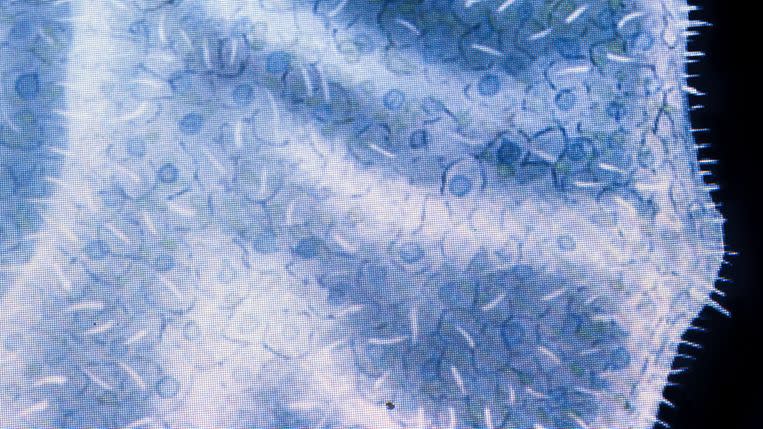This Blob Is the Size of a Grain of Sand. It's the Key to Unlocking Human Evolution.

A millimeter-sized sea animal could hold clues to the evolution of the human nervous system.
While placozoans are simple animals only as big as a grain of sand, the blobs have unique cells that could have been precursors to more complex animals.
One researcher called the placozoan a true “evolutionary stepping stone.”
The placozoan is oh-so-tiny. We’re talking one-millimeter teeny—the itty-bitty marine animal is only the size of a large grain of sand. And it’s just a simple disc-like blob grazing on algae and microbes.
But researchers are giddy over learning about how the creature’s peptidergic cells coordinate its movements—in part because they believe that understanding a placozoan’s peptidergic cells could open the door to an ocean of knowledge about the evolution of the human nervous system.
That’s quite a leap for such a minuscule animal. But it’s one that researchers at the Centre for Genomic Regulation believe in. The group published a study in the journal Cell that highlights how the specialized secretory cells found in the ancient creatures may have given rise to neurons in more complex animals.
“We are astounded by the parallels,” Sebastian Najle, co-first author of the study and researcher at the Centre for Genomic Regulation, said in a news release. “The placozoan peptidergic cells have many similarities to primitive neuronal cells, even if they aren’t quite there yet. It’s like looking at an evolutionary stepping stone.”
The pancake-shaped creature is so simple that it has no body parts or organs, but scientists theorize that the placozoan is one of the oldest animals on Earth, and one of five main lineages of animals. Instead of using more complex neurons to structure behavior, the placozoan uses peptidergic cells, which release small peptides to direct the animal’s movement or feeding. The intriguing nature of these cells launched the study, and researchers used computational models to understand how placozoan cell types may have evolved.
The team mapped the creature’s different cell types, uncovering what each cell does and how they work together. The team found that nine main cell types in placozoans appear to be connected to “in-between” cell types—ones that can change from one type to another. These cells can grow and divide, helping maintain the balance of cells needed for the animal to move and eat. They also found 14 different pepitdergic cells with no growth or division, noting that these cells were very similar to early neurons.
That’s where things got interesting. Using cross-species analysis, the team showed that these cell constructions are unique to placozoans. The study notes that the findings “indicate that key neuronal development and effector gene modules evolved before the advent of cnidarian/bilaterian neurons in the context of paracrine cell signaling.”
Over the course of the study, the team discovered three key similarities between peptidergic cells and neurons—they both differ from progenitor epithelial cells, they require many gene modules to be able to send messages, and they can communicate with with proteins.
“Placozoans lack neurons, but we’ve now found striking molecular similarities with our neural cells,” Xavier Grau-Boye, co-first author of the study and researcher at the Centre for Genomic Regulation, said in a news release. “Did neurons evolve once and then diverge, or more than once, in parallel? Are they a mosaic, where each piece has a different origin? These are open questions that remained to be addressed.”
The team believes that understanding the placozoan’s cells can help us to understand how early neurons may have formed. Sequencing high-quality genomes from a diverse set of sepcies may clear up some of the remaining unknowns.
“Cells are the fundamental units of life, so understanding how they come into being or change over time is key to explain the evolutionary story of life,” Arnaeu Sebe-Pedros, corresponding study author and research professor at the Centre for Genomic Regulation, said in a news release. “Placozoans, ctenophores, sponges, and other non-traditional model animals harbor secrets that we are only just beginning to unlock.”
Not bad for a blob.
You Might Also Like
